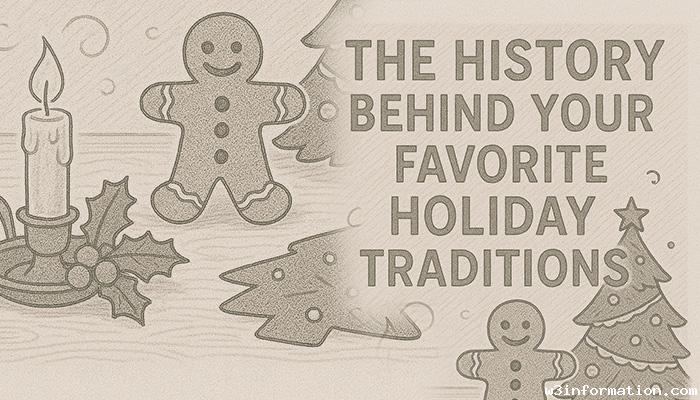The History Behind Your Favorite Holiday Traditions
The celebration of holidays typically features deep-rooted traditions which unite families and communities in joyful gatherings. Each tradition from decorating Christmas trees to lighting menorahs and from hunting Easter eggs to feasting on turkey during Thanksgiving holds historical significance and cultural importance while also developing new interpretations over time. Exploring the background of our cherished holiday traditions enhances our understanding and strengthens our connection to historical and contemporary times. This article examines various popular holiday customs worldwide by investigating their beginnings and histories.
The Origins of Christmas Traditions
The Christmas Tree: From Pagan Roots to Modern Symbol
The Christmas tree stands as one of the key traditional symbols of the Christmas holiday. Ancient pagan customs in Europe introduced the practice of bringing evergreen trees into homes because people viewed fir, pine, and spruce trees as representations of eternal life. The winter solstice saw people using evergreen trees in home decorations to honor the upcoming return of spring.
The tradition of the modern Christmas tree started in Germany during the 16th century. Martin Luther is given credit for the practice of placing candles on trees so they resembled the stars shining through the night sky while devout Christians brought decorated trees into their homes. Europe adopted this custom which became popular in English-speaking regions during the 19th century following Queen Victoria and Prince Albert's public display of their decorated Christmas tree in the 1840s through widespread illustrations.
The Christmas tree tradition we know today merges ancient customs with Christian elements and stands as a universal representation of holiday spirit that honors hope, life, and celebration.
Yule Log: A Fire Tradition with Ancient Origins
Ancient Norse practices and Celtic solstice festivities serve as the foundation for the Yule log tradition. During the midwinter Yule festival people celebrated the sun's return by burning large logs in their hearths to provide light and heat during the year's darkest period.
Medieval European families brought a specific log into their homes and ignited it during prayers for protection and prosperity for the upcoming year. People preserved Yule log ashes as protective charms or magical items. The tradition developed through time into multiple forms with the most well-known contemporary version being the chocolate Yule log cake served at Christmas celebrations.
The Yule log represents warmth and light while also embodying the concept of renewal through which many winter holiday customs find meaning.

Hanukkah Traditions: Light Amid Darkness
The Menorah: Commemorating a Miraculous History
Hanukkah is the Jewish Festival of Lights that honors the restoration of Jerusalem's Second Temple during the 2nd century BCE after the Maccabean Revolt against the Seleucid rulers. A nine-branched candelabrum known as the menorah stands as Hanukkah's most lasting symbol.
Hanukkah honors the miracle when Temple oil that should have lasted only one day burned for eight consecutive days. The celebration requires lighting one candle on the menorah each night for eight nights with the shamash candle serving as the lighting tool.
The religious practice of lighting the menorah represents a cultural cornerstone for Hanukkah which embodies hope and divine intervention as well as human perseverance through difficult times.
Dreidel: A Game Rooted in Resistance
The dreidel game played during Hanukkah serves as something greater than mere entertainment. The spinning top used during Hanukkah features four Hebrew letters: nun, gimel, hei, and shin to represent the phrase "Nes Gadol Haya Sham" which means "a great miracle happened there".
In times when oppressive rulers banned Jewish study children used the dreidel game to secretly practice their Torah learning. The game functioned as a hidden way to express cultural and religious defiance.
Playing dreidel today allows families to connect with their ancestral heritage and the lasting spirit of their forebears.
Easter Traditions: Symbols of Renewal and Resurrection
Easter Eggs: Easter eggs trace their origins to ancient fertility practices before becoming symbols in Christian celebrations.
Across different cultures worldwide eggs represent fertility and new life during springtime celebrations. Decorated eggs became a tradition at early pagan celebrations to honor spring's arrival and the theme of rebirth while people exchanged them as gifts.
As Christianity spread throughout Europe the egg developed a symbolic representation of Jesus Christ’s resurrection along with faith’s promise of new life. Throughout Lent medieval Christians refrained from consuming eggs but began egg decoration at Easter to signal their fasting period's conclusion.
Egg decorating developed into various modern customs including Ukraine's detailed pysanky patterns as well as worldwide Easter egg hunts.
The Easter Bunny: The Easter Bunny serves as a folklore figure that links pagan traditions with Christian customs.
German folklore is credited with creating the Easter Bunny character known as the Easter Hare. Hares represented fertility and rebirth in symbolism and folklore about an Easter Hare describes it laying eggs for children to discover.
German immigrants introduced this tradition to America during the 1700s where it developed into the well-known figure who gives out eggs and presents at Easter festivities.
Today's secular Easter Bunny originates from folklore which celebrates themes of fertility and hope.
Thanksgiving Traditions: A Feast of Gratitude and History
The First Thanksgiving: Myth Versus Reality
The Thanksgiving narrative typically describes a peaceful gathering where Pilgrims and Native Americans came together to feast in 1621. The historical events surrounding the harvest celebration were more intricate than simple festivities since they encompassed cooperation and conflict as well as cultural exchange.
Historical records provide insights into the traditional Thanksgiving meal of turkey, corn, and pumpkin which settlers and Wampanoag people likely shared together.
In the 19th century Sarah Josepha Hale and Abraham Lincoln established the modern Thanksgiving tradition by declaring it a national holiday during the Civil War to bring the nation together in thanks.
The Thanksgiving holiday currently stands as a moment for people to examine their feelings of thankfulness and familial bonds while acknowledging the complex history of America.
The Turkey: From Wild Game to Festive Staple
The turkey originated in North America and historical data indicates that Indigenous peoples consumed it before European colonization. Turkey's widespread availability and substantial size made it an excellent choice for group meals which led to its association with Thanksgiving.
The Thanksgiving feast centers around roasted turkey which represents abundance and festive spirit.
The turkey now represents cultural significance during Thanksgiving beyond its role as a dish and is also part of traditions such as the United States’ National Turkey Pardon.
New Year’s Traditions: Welcoming Time’s Fresh Start
Fireworks and Noise: Scaring Away Evil Spirits
The practice of lighting fireworks and creating noise at midnight during New Year's Eve celebrations traces back to ancient traditions. Many cultures agreed that the combination of loud noises and bright lights could protect against evil spirits and unfavorable circumstances which allowed a new year full of opportunities to begin.
Chinese New Year celebrations established this tradition through the utilization of firecrackers to scare away mythical creatures. The tradition became universally adopted and became part of Western New Year’s celebrations.
Fireworks today represent both festive occasions and humanity's wish to purify and revitalize itself.
Resolutions: Ancient Practices of Self-Reflection
The tradition of making New Year’s resolutions originated with ancient Babylonians who started each year by making promises to their gods. They sought to gain divine approval and bring about good fortune.
The Romans maintained this tradition by dedicating the first day of the new year to Janus who represented beginnings and endings while observing both past and future.
Today’s New Year’s resolutions represent secular adaptations of ancient rituals while expressing the desire for personal growth and positive transformation in the coming year.
Conclusion: The Living Legacy of Holiday Traditions
The enduring nature of holiday traditions reflects their historical and cultural foundations while adapting to change over time. These traditions demonstrate human resilience and creativity while revealing our shared need to celebrate life's cycles and connections. Every holiday decoration, ritual, and special meal tells its own tale of historical religious beliefs and cultural adjustments that bring communities together in celebration.
Exploring the origins of our festive traditions enables us to appreciate our celebrations more profoundly and connects us with our ancestors. The glowing candles of the menorah alongside the vibrant Easter eggs and the warmth of a Thanksgiving feast connect people across generations and geographies while creating new memories and honoring the past.
When we delve into the origins of our holiday traditions we deepen our celebration's meaning and understand that holidays function as essential components of human culture beyond their calendar dates.
 DIY Holiday Decor Ideas on a Budget
DIY Holiday Decor Ideas on a Budget
 How to Create a Healthy Meal Plan for the Week
How to Create a Healthy Meal Plan for the Week
 Discover your top 10 comforting meals to enjoy during the winter season
Discover your top 10 comforting meals to enjoy during the winter season
 Tips for Stress-Free Holiday Travel
Tips for Stress-Free Holiday Travel
 Mobile Video Editing Apps to Try
Mobile Video Editing Apps to Try
 Mobile Health Apps: Best of 2025
Mobile Health Apps: Best of 2025